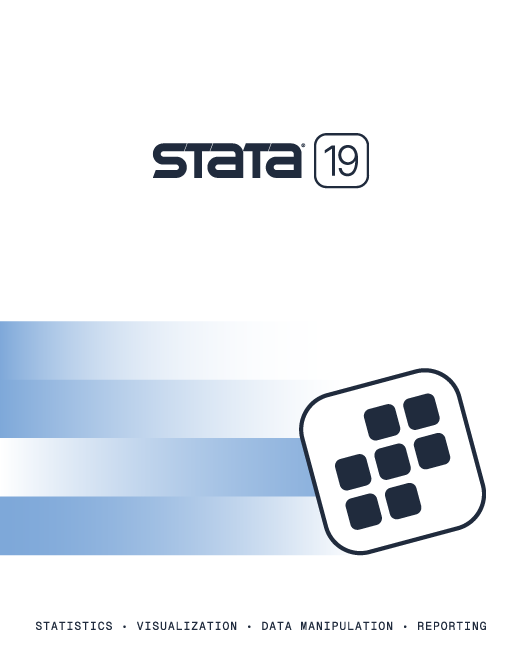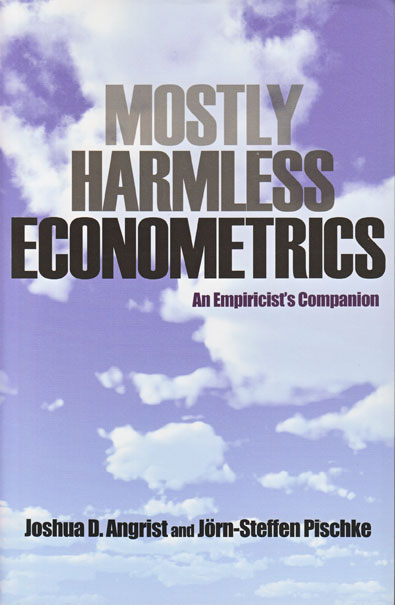

2025 Stata Conference • Nashville, TN • 31 July–01 August
Mostly Harmless Econometrics: An Empiricist's Companion |
||||||||||||||||||||||||||||||||||||
 Click to enlarge See the back cover |

As an Amazon Associate, StataCorp earns a small referral credit from
qualifying purchases made from affiliate links on our site.
eBook not available for this title
eBook not available for this title |
Review of this book from the Stata Journal |
||||||||||||||||||||||||||||||||||
Comment from the Stata technical groupAll graduate students and researchers should read Mostly Harmless Econometrics: An Empiricist’s Companion, by Joshua D. Angrist and Jörn-Steffen Pischke. This instructive and irreverent romp through microeconometrics is as much of a page turner as we are likely to see in a book about statistical methods. Angrist and Pischke provide an excellent introduction to microeconometrics from the potential-outcomes approach. They advocate using the potential-outcomes approach as the method to identify and interpret causal effects, which can be estimated by the methods discussed in the book. The authors provide many examples of how this approach has been applied in recent empirical work and closely link these empirical papers to the methods discussed. The book covers ordinary least squares, generalized least squares, instrumental variables, panel-data estimators, regression-discontinuity methods, quantile regression, and standard-error estimation. Maximum-likelihood methods are not discussed in detail; in fact, Angrist and Pischke argue that simple regression methods frequently provide more robust estimators of the causal effects of interest in cases where maximum-likelihood methods are traditionally used. This book will be required reading; methods experts and practitioners are already discussing its pros and cons. Fortunately, Angrist and Pischke have made this book as entertaining as it is informative. |
||||||||||||||||||||||||||||||||||||
Table of contentsView table of contents >> List of Figures
List of Tables
Preface
Acknowledgments
Organization of This Book
I Preliminaries
1 Questions about Questions
2 The Experimental Ideal
2.1 The Selection Problem
2.2 Random Assignment Solves the Selection Problem 2.3 Regression Analysis of Experiments II The Core
3 Making Regression Make Sense
3.1 Regression Fundamentals
3.2 Regression and Causality 3.3 Heterogeneity and Nonlinearity 3.4 Regression Details 3.5 Appendix: Derivation of the Average Derivative Weighting Function 4 Instrumental Variables in Action: Sometimes You Get What
You Need
4.1 IV and Causality
4.2 Asymptotic 2SLS Inference 4.3 Two-Sample IV and Split-Sample IV 4.4 IV with Heterogeneous Potential Outcomes 4.5 Generalizing LATE 4.6 IV Details 4.7 Appendix 5 Parallel Worlds: Fixed Effects,
Differences-in-Differences, and Panel Data
5.1 Individual Fixed Effects
5.2 Differences-in-Differences 5.3 Fixed Effects versus Lagged Dependent Variables 5.4 Appendix: More on Fixed Effects and Lagged Dependent Variables III Extensions
6 Getting a Little Jumpy: Regression Discontinuity Designs
6.1 Sharp RD
6.2 Fuzzy RD Is IV 7 Quantile Regression
7.1 The Quantile Regression Model
7.2 IV Estimation of Quantile Treatment Effects 8 Nonstandard Standard Error Issues
8.1 The Bias of Robust Standard Error Estimates
8.2 Clustering and Serial Correlation in Panels 8.3 Appendix: Derivation of the Simple Moulton Factor Last Words
Acronyms and Abbreviations
Empirical Studies Index
References
Index
|
||||||||||||||||||||||||||||||||||||
Learn
Free webinars
NetCourses
Classroom and web training
Organizational training
Video tutorials
Third-party courses
Web resources
Teaching with Stata
© Copyright 1996–2025 StataCorp LLC. All rights reserved.
×
We use cookies to ensure that we give you the best experience on our website—to enhance site navigation, to analyze usage, and to assist in our marketing efforts. By continuing to use our site, you consent to the storing of cookies on your device and agree to delivery of content, including web fonts and JavaScript, from third party web services.
Cookie Settings
Last updated: 16 November 2022
StataCorp LLC (StataCorp) strives to provide our users with exceptional products and services. To do so, we must collect personal information from you. This information is necessary to conduct business with our existing and potential customers. We collect and use this information only where we may legally do so. This policy explains what personal information we collect, how we use it, and what rights you have to that information.
These cookies are essential for our website to function and do not store any personally identifiable information. These cookies cannot be disabled.
This website uses cookies to provide you with a better user experience. A cookie is a small piece of data our website stores on a site visitor's hard drive and accesses each time you visit so we can improve your access to our site, better understand how you use our site, and serve you content that may be of interest to you. For instance, we store a cookie when you log in to our shopping cart so that we can maintain your shopping cart should you not complete checkout. These cookies do not directly store your personal information, but they do support the ability to uniquely identify your internet browser and device.
Please note: Clearing your browser cookies at any time will undo preferences saved here. The option selected here will apply only to the device you are currently using.